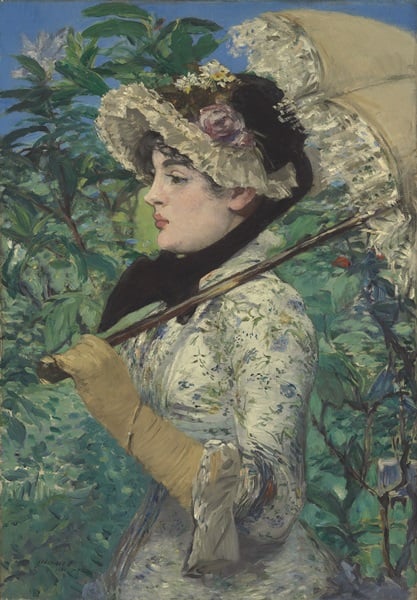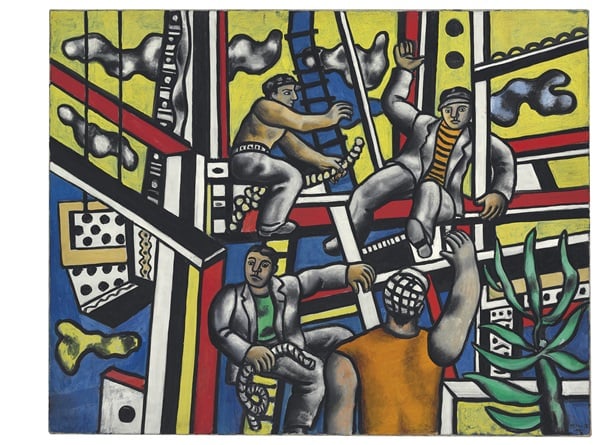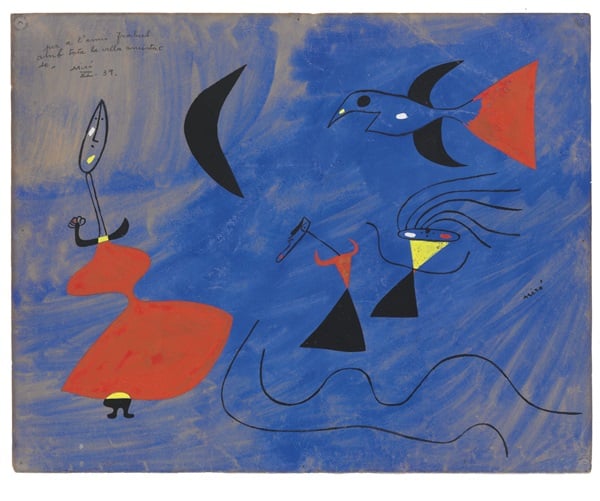Analysis
$65 Million Manet Leads at Christie’s $165 Million Impressionist and Modern Art Sale
And a 1939 gouache on paper by Joan Miró sells for $1.2 million.

And a 1939 gouache on paper by Joan Miró sells for $1.2 million.

by
Eileen Kinsella

Christie’s sale of Impressionist and modern art this evening totaled $165.6 million, well exceeding the expectation of about $110 million. Of 39 lots on offer (one was withdrawn), 35, or 90 percent, found buyers. By value the sale was 87 percent sold.
After last night’s marathon session of 73 lots at Sotheby’s, this was by comparison a much quicker and tightly curated sale. While it was far more tame than last evening’s sale, which saw five lots selling for more than $20 million each, tonight’s sale appeared to be on target for matching supply and demand at appropriate price points. The only “blockbusters” slated here were Édouard Manet‘s quintessential Impressionist painting Le Printemps (1881), estimated at $25–35 million, and Fernand Léger’s bold and colorful Les constructeurs avec arbre (1949), which was estimated to sell for $16–22 million, and was a major disappointment of the evening.
For his Le Printemps (lot 16) Manet cast French actress Jeanne Demarsy as an “allegory of spring” with a specially designed flowered dress, a parasol, and a blossom-bedecked bonnet. He posed her in profile—a nod, experts say, to early Renaissance portraits of young noblewomen. The artist was also making a reference to the way seasons in Japanese Ukiyo-e color prints are portrayed in the guise of beautiful women, according to the Christie’s catalogue. Manet had intended to execute four paintings, one for each season, but only finished spring and autumn.
Le Printemps sold for $65.1 million with premium. Bidding opened at $18 million and was chased by at least five bidders, most of whom were on the phone with Christie’s specialists. At $47 million, a new buyer seated in the room went bid for bid with Impressionist specialist Brooke Lampley, the head of the sale. Sometimes the bids rose in half-million dollar increments, sometimes in full $1 million increments. The buyer in the room who won the work for a hammer price of $58 million, reportedly was dealer Otto Naumann, who acquired the work on behalf of the J. Paul Getty Museum in Los Angeles.
Another topseller was a Giacometti sculpture, Stèle III (conceived in 1958 and cast in 1962), which sold for $9.9 million, on an estimate of $4.5–6.5 million.

Lot 28, Fernand Léger’s Les constructeurs avec arbre (1949–50) did not draw any bids in the room on an estimate of $16–22 million and was sold to a reserve, or order, bid of $15.5 million.
Courtesy Christie’s Images Ltd.
The action was decidedly tepid for Fernand Léger‘s Les constructeurs avec arbre (1949–50), once owned by casino mogul and top collector Steve Wynn (and ex-husband of Elaine Wynn, the winner of the $142.4 million Francis Bacon triptych “Three Studies of Lucian Freud” at Christie’s last November). The Léger is described in the Christie’s catalogue as the artist’s “paean to the salt-of-the-earth working man, both as a class within French society and in the industrialized world generally.”
Auctioneer Andreas Rumbler opened bidding at $12 million, and, despite no visible bids in the room, ticked up the price to $14, and then $15 million. As he held the bidding open, the tension in the room became increasingly palpable, since it was that clear not a single bid was emerging from the phone bank of specialists standing to Rumbler’s right. The auctioneer brought the hammer down and announced that the work had been sold to “the book”—a reserve bid for $15.5 million. Afterwards, it was not visible on Christie’s website as a sold lot and did not appear on the auctioneer’s list of 10 highest lots released. A Christie’s representative noted that it had a guarantee and counts as a buy-in.
For some lots, being off the block for a considerable length of time barely made a dent in value. Surprisingly, Renoir‘s La jeune fille au cygne ou La jeune fille au héron (lot 19) carried the exact same $5–7 million estimate tonight that it did 17 years ago. It hammered at $5 million, or $5.8 million with premium. The Renoir was last at auction at Christie’s New York in November 1997; back then it realized $5 million with premium.
The buyer of the Renoir, a woman seated in the front row of the salesroom, then successfully bid for Georges Braque‘s Guitare et rhum (1918) (lot 25), which sold for $4.6 million, well above its $2–3 million estimate. The Nahmad family of art dealers was the underbidder.
The Nahmads, who bid actively throughout the evening, were more successful in their pursuit of another guitar, Pablo Picasso‘s Guitare (1920), which they won to the tune of $5.3 million on an estimate of $3–5 million.

An untitled 1939 gouache on paper by Joan Miró sold for $1.2 million on an estimate of $400–600,000.
According to the Christie’s catalogue, “this gouache is the record of the reunion between Miró and a dear Catalan friend, the writer Francesc Trabal,” who was the author of “the first-ever interview to feature the artist, which the Catalan nationalist newspaper La publicitat, Barcelona, published on 14 July 1928.”
Courtesy Christie’s Images Ltd.
Spanish painter Joan Miró was well-represented by five works totaling a minimum collective estimate of $12.7 million (the high end was $19.3 million). Peinture (1953), with an estimate of $5–8 million, drew no bids in the salesroom and was hammered down to an order bid of $4.3 million.
The others were: Tuilerie à Mont-roig (1918), an atypical early landscape that sold for $8.7 million on an estimate of $5–7 million; Femme et oiseau (1967), a sculpture that sold for $1.6 million on an estimate of $1.5–2.5 million; La Cafetière (1915), a painting that sold for $725,000 on an estimate of $800,000–1.2 million; and a brilliant-blue untitled 1939 gouache on paper that sold for $1.2 million on an estimate of $400,000–600,000. The blue Miró set the room abuzz, proving, for a change, that red is not the only winning color at auction.